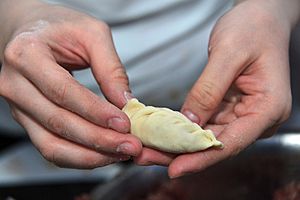Pelmeni facts for kids

Pelmeni served with smetana (sour cream)
|
|
| Type | Dumpling |
|---|---|
| Place of origin | Russia (Ural and Siberia) |
| Main ingredients | Dough: flour, water, sometimes eggs Filling: minced meat (pork, lamb, beef, fish, or any other kind of meat) or mushrooms as well as salt, pepper and sometimes herbs and onions. |
Pelmeni (Russian: пельмени) are a type of dumpling from Russian cuisine. They have a tasty filling wrapped inside thin dough. The word "pelmeni" is plural, meaning more than one. If you talk about just one, it's called a "pelmen" (Russian: пельмень).
People often say pelmeni are "the heart of Russian cuisine." It's not totally clear if they first came from the Ural mountains or Siberia.
Contents
What are Pelmeni Made Of?
The outer part of pelmeni is a thin dough. It's usually made from flour and water. Sometimes, a little bit of egg is added to the dough.
The inside, or filling, can be made from different things. Most often, it's minced (finely chopped) meat. This can be pork, lamb, beef, or even fish. Some recipes use venison, which is deer meat, especially in colder areas. You can also find pelmeni with mushrooms inside, or a mix of meat and mushrooms.
Many people like to mix different kinds of meat for the filling. For example, a traditional recipe from Udmurtia uses a mix of beef, mutton, and pork. Spices like black pepper, chopped onions, and garlic are also mixed into the filling.
When pelmeni are cooked, they are often served with toppings. Popular choices include sour cream (called smetana), mayonnaise, fresh dill, red onions, or vinegar. These toppings are common in Russia and Siberia. Sometimes, small amounts of cabbage, tomato, or horseradish are added directly to the meat filling.
Where Did Pelmeni Come From?
The idea of dumplings, or food wrapped in dough, has been around for a long time. Some ancient Greek dishes were similar. However, many believe that pelmeni as we know them came from the Ural region of Russia.
The name "pelmeni" comes from the Komi and Udmurt languages. In these languages, "pel'n'an" means "ear bread." This makes sense because pelmeni often look like little ears!
It's not clear exactly when pelmeni became popular in Russian cooking. One idea is that they came from Siberia. They might be a simpler version of Chinese dumplings called jiaozi. Another idea is that the Mongols brought them to Siberia and the Urals. From there, they slowly spread across Eastern Europe. Pelmeni became very popular with Russian hunters.
Pelmeni were also a great way to store meat during the long, cold Siberian winters. People could freeze them outside. This meant they didn't have to feed their animals all winter. So, even if they started in the Urals, the Siberian way of life really shaped how pelmeni were used.
How are Pelmeni Different?
Pelmeni are part of a big family of dumplings found around the world. They are similar to Ukrainian varenyky and Polish uszka. In some countries, people might call all Eastern European dumplings "pierogi."
Pelmeni also have cousins in other parts of Asia and Europe. These include Mongolian bansh, Chinese jiaozi and húndùn (like wontons), Turkish manti, Georgian khinkali, Nepalese momo, Korean mandu, and Japanese gyoza. In Italy, tortellini and ravioli are also similar.
Here are some key differences:
- Dough Thickness: Pelmeni have very thin dough. The amount of filling is usually much more than the dough.
- Sweet Fillings: Pelmeni are never made with sweet fillings. This is different from varenyky and Polish pierogi, which sometimes have sweet fillings like fruit.
- Raw vs. Cooked Fillings: The fillings in pelmeni are usually raw before cooking. For varenyky and pierogi, the fillings are often cooked beforehand.
- Size: A typical pelmen is about 2 to 3 centimeters (about 1 inch) across. Momos, another type of dumpling, are often twice that size.
How are Pelmeni Eaten?
In Siberia, people traditionally freeze pelmeni outdoors in winter. They are like a stored food that lasts a long time. Hunters or explorers would carry bags of frozen pelmeni. They were easy to cook and provided a good meal.
To cook pelmeni, you boil them in salted water. They are ready when they float to the top, plus a few more minutes (usually 2 to 5 minutes). In the Ural region, they are often boiled in plain water. In Siberia, they might be boiled in salted water or even meat broth.
Cooked pelmeni can be served plain. Or, they can be topped with melted butter or smetana (sour cream). Other toppings include mustard, horseradish, tomato sauce, and vinegar. In the Russian Far East, people often add soy sauce.
Some recipes suggest frying pelmeni after boiling them. You cook them until they turn golden brown. Pelmeni can also be served in a clear soup. However, in Siberia, many people prefer them strained and served without soup. In Tatar cuisine, pilmän (their version of pelmeni) are always served with clear soup and fresh dill or other herbs. Pelmeni are also a part of Polish cuisine.
You can find frozen pelmeni in many stores today, especially in places with Russian or Ukrainian communities. These are often called "Siberian pelmeni." Large machines make these store-bought pelmeni. They usually weigh about 15 grams (half an ounce) each. They look a bit like larger versions of Italian tortellini.
Many families also make pelmeni at home. The easiest way is by hand, but it takes time. Many cooks use special "pelmeni makers." These are molds that look like muffin pans or ravioli molds. They help you quickly make many pelmeni from two sheets of dough and some meat filling.
In modern Russian culture, store-bought pelmeni are seen as a quick and easy meal, like instant ramen. But homemade pelmeni are thought of as a healthy and filling meal.
See also
 In Spanish: Pelmeni para niños
In Spanish: Pelmeni para niños




